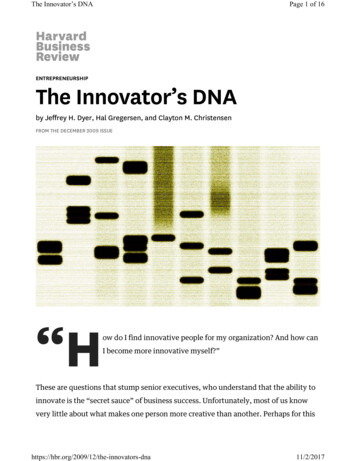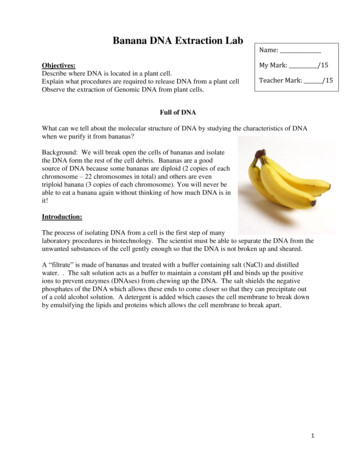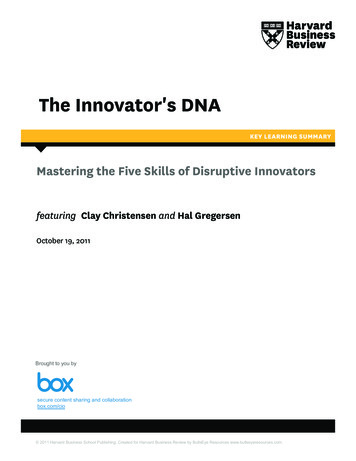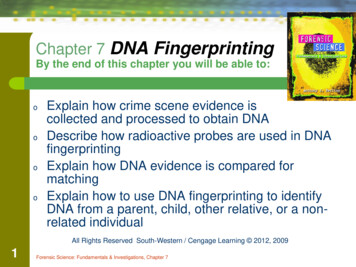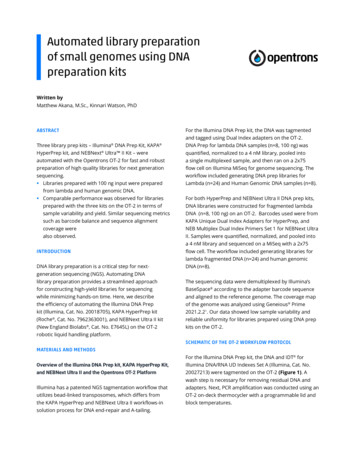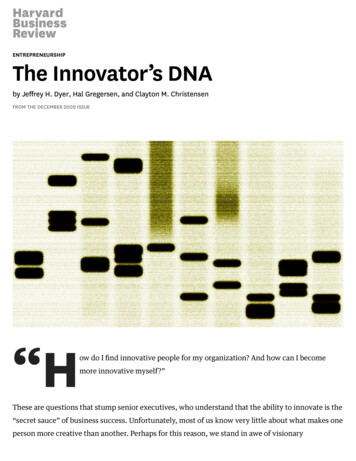
Transcription
ENTREPRENEURSHIPThe Innovator’s DNAby Jeffrey H. Dyer, Hal Gregersen, and Clayton M. ChristensenFROM THE DECEMBER 2009 ISSUE“How do I find innovative people for my organization? And how can I becomemore innovative myself?”These are questions that stump senior executives, who understand that the ability to innovate is the“secret sauce” of business success. Unfortunately, most of us know very little about what makes oneperson more creative than another. Perhaps for this reason, we stand in awe of visionary
entrepreneurs like Apple’s Steve Jobs, Amazon’s Jeff Bezos, eBay’s Pierre Omidyar, and P&G’s A.G.Lafley. How do these people come up with groundbreaking new ideas? If it were possible to discoverthe inner workings of the masters’ minds, what could the rest of us learn about how innovationreally happens?In searching for answers, we undertook a six-year study to uncover the origins of creative—andoften disruptive—business strategies in particularly innovative companies. Our goal was to putinnovative entrepreneurs under the microscope, examining when and how they came up with theideas on which their businesses were built. We especially wanted to examine how they differ fromother executives and entrepreneurs: Someone who buys a McDonald’s franchise may be anentrepreneur, but building an Amazon requires different skills altogether. We studied the habits of25 innovative entrepreneurs and surveyed more than 3,000 executives and 500 individuals who hadstarted innovative companies or invented new products.We were intrigued to learn that at most companies, top executives do not feel personallyresponsible for coming up with strategic innovations. Rather, they feel responsible for facilitatingthe innovation process. In stark contrast, senior executives of the most innovative companies—amere 15% in our study—don’t delegate creative work. They do it themselves.But how do they do it? Our research led us to identify five “discovery skills” that distinguish themost creative executives: associating, questioning, observing, experimenting, and networking. Wefound that innovative entrepreneurs (who are also CEOs) spend 50% more time on these discoveryactivities than do CEOs with no track record for innovation. Together, these skills make up what wecall the innovator’s DNA. And the good news is, if you’re not born with it, you can cultivate it.What Makes Innovators Different?Innovative entrepreneurs have something called creative intelligence, which enables discovery yetdiffers from other types of intelligence (as suggested by Howard Gardner’s theory of multipleintelligences). It is more than the cognitive skill of being right-brained. Innovators engage both sidesof the brain as they leverage the five discovery skills to create new ideas.
In thinking about how these skills work together, we’ve found it useful to apply the metaphor ofDNA. Associating is like the backbone structure of DNA’s double helix; four patterns of action(questioning, observing, experimenting, and networking) wind around this backbone, helping tocultivate new insights. And just as each person’s physical DNA is unique, each individual we studiedhad a unique innovator’s DNA for generating breakthrough business ideas.Imagine that you have an identical twin, endowed with the same brains and natural talents that youhave. You’re both given one week to come up with a creative new business-venture idea. During thatweek, you come up with ideas alone in your room. In contrast, your twin (1) talks with 10 people—including an engineer, a musician, a stay-at-home dad, and a designer—about the venture, (2) visitsthree innovative start-ups to observe what they do, (3) samples five “new to the market” products,(4) shows a prototype he’s built to five people, and (5) asks the questions “What if I tried this?” and“Why do you do that?” at least 10 times each day during these networking, observing, andexperimenting activities. Who do you bet will come up with the more innovative (and doable) idea?Studies of identical twins separated at birth indicate that our ability to think creatively comes onethird from genetics; but two-thirds of the innovation skill set comes through learning—firstunderstanding a given skill, then practicing it, experimenting, and ultimately gaining confidence inone’s capacity to create. Innovative entrepreneurs in our study acquired and honed their innovationskills precisely this way.Let’s look at the skills in detail.Discovery Skill 1: AssociatingAssociating, or the ability to successfully connect seemingly unrelated questions, problems, or ideasfrom different fields, is central to the innovator’s DNA. Entrepreneur Frans Johansson described thisphenomenon as the “Medici effect,” referring to the creative explosion in Florence when the Medicifamily brought together people from a wide range of disciplines—sculptors, scientists, poets,philosophers, painters, and architects. As these individuals connected, new ideas blossomed at theintersections of their respective fields, thereby spawning the Renaissance, one of the most inventiveeras in history.
To grasp how associating works, it is important to understand how the brain operates. The braindoesn’t store information like a dictionary, where you can find the word “theater” under the letter“T.” Instead, it associates the word “theater” with any number of experiences from our lives. Someof these are logical (“West End” or “intermission”), while others may be less obvious (perhaps“anxiety,” from a botched performance in high school). The more diverse our experience andknowledge, the more connections the brain can make. Fresh inputs trigger new associations; forsome, these lead to novel ideas. As Steve Jobs has frequently observed, “Creativity is connectingthings.”The world’s most innovative companies prosper by capitalizing on the divergent associations oftheir founders, executives, and employees. For example, Pierre Omidyar launched eBay in 1996after linking three unconnected dots: (1) a fascination with creating more-efficient markets, afterhaving been shut out from a hot internet company’s IPO in the mid-1990s; (2) his fiancée’s desire tolocate hard-to-find collectible Pez dispensers; and (3) the ineffectiveness of local classified ads inlocating such items. Likewise, Steve Jobs is able to generate idea after idea because he has spent alifetime exploring new and unrelated things—the art of calligraphy, meditation practices in anIndian ashram, the fine details of a Mercedes-Benz.Associating is like a mental muscle that can grow stronger by using the other discovery skills. Asinnovators engage in those behaviors, they build their ability to generate ideas that can berecombined in new ways. The more frequently people in our study attempted to understand,categorize, and store new knowledge, the more easily their brains could naturally and consistentlymake, store, and recombine associations.Discovery Skill 2: QuestioningMore than 50 years ago, Peter Drucker described the power of provocative questions. “Theimportant and difficult job is never to find the right answers, it is to find the right question,” hewrote. Innovators constantly ask questions that challenge common wisdom or, as Tata Groupchairman Ratan Tata puts it, “question the unquestionable.” Meg Whitman, former CEO of eBay, hasworked directly with a number of innovative entrepreneurs, including the founders of eBay, PayPal,and Skype. “They get a kick out of screwing up the status quo,” she told us. “They can’t bear it. Sothey spend a tremendous amount of time thinking about how to change the world. And as theybrainstorm, they like to ask: ‘If we did this, what would happen?’”
Most of the innovative entrepreneurs we interviewed could remember the specific questions theywere asking at the time they had the inspiration for a new venture. Michael Dell, for instance, toldus that his idea for founding Dell Computer sprang from his asking why a computer cost five timesas much as the sum of its parts. “I would take computers apart and would observe that 600 worthof parts were sold for 3,000.” In chewing over the question, he hit on his revolutionary businessmodel.To question effectively, innovative entrepreneursSample of InnovativeEntrepreneurs from our Studydo the following:Sam Allen: ScanCafe.comAsk “Why?” and “Why not?” and “Whatif?”Marc Benioff:Salesforce.comJeff Bezos: Amazon.comMike Collins: Big Idea GroupMost managers focus on understanding how tomake existing processes—the status quo—work alittle better (“How can we improve widget sales inScott Cook: IntuitTaiwan?”). Innovative entrepreneurs, on theMichael Dell: Dell Computerother hand, are much more likely to challengeAaron Garrity: XanGoassumptions (“If we cut the size or weight of theDiane Green: VMWarewidget in half, how would that change the valueEliot Jacobsen: RocketFuelproposition it offers?”). Marc Benioff, the founderJosh James: OmnitureChris Johnson: Terra Novaof the online sales software providerSalesforce.com, was full of questions afterwitnessing the emergence of Amazon and eBay,Jeff Jones: NxLight; Campus Pipelinetwo companies built on services delivered via theHerb Kelleher: Southwest Airlinesinternet. “Why are we still loading and upgradingMike Lazaridis: Research In Motionsoftware the way we’ve been doing all this timeSpencer Moffat: Fast Arch of Utahwhen we can now do it over the internet?” heDavid Neeleman: JetBlue; Morris Airwondered. This fundamental question was thePierre Omidyar: eBayJohn Pestana: OmniturePeter Thiel: PayPalgenesis of Salesforce.com.Imagine opposites.In his book The Opposable Mind, Roger MartinMark Wattles: Hollywood Videowrites that innovative thinkers have “the capacityCorey Wride: Movie Mouthto hold two diametrically opposing ideas in their
Niklas ZennstrÖm: Skypeheads.” He explains, “Without panicking orsimply settling for one alternative or the other,they’re able to produce a synthesis that issuperior to either opposing idea.”Innovative entrepreneurs like to play devil’s advocate. “My learning process has always been aboutdisagreeing with what I’m being told and taking the opposite position, and pushing others to reallyjustify themselves,” Pierre Omidyar told us. “I remember it was very frustrating for the other kidswhen I would do this.” Asking oneself, or others, to imagine a completely different alternative canlead to truly original insights.Embrace constraints.Most of us impose constraints on our thinking only when forced to deal with real-world limitations,such as resource allocations or technology restrictions. Ironically, great questions actively imposeconstraints on our thinking and serve as a catalyst for out-of-the-box insights. (In fact, one ofGoogle’s nine innovation principles is “Creativity loves constraint.”) To initiate a creative discussionabout growth opportunities, one innovative executive in our study asked this question: “What if wewere legally prohibited from selling to our current customers? How would we make money nextyear?” This led to an insightful exploration of ways the company could find and serve newcustomers. Another innovative CEO prods his managers to examine sunk-cost constraints by asking,“What if you had not already hired this person, installed this equipment, implemented this process,bought this business, or pursued this strategy? Would you do the same thing you are doing today?”Discovery Skill 3: ObservingDiscovery-driven executives produce uncommon business ideas by scrutinizing commonphenomena, particularly the behavior of potential customers. In observing others, they act likeanthropologists and social scientists.Intuit founder Scott Cook hit on the idea for Quicken financial software after two key observations.First he watched his wife’s frustration as she struggled to keep track of their finances. “Often thesurprises that lead to new business ideas come from watching other people work and live theirnormal lives,” Cook explained. “You see something and ask, ‘Why do they do that? That doesn’tmake sense.’” Then a buddy got him a sneak peek at the Apple Lisa before it launched. Immediately
after leaving Apple headquarters, Cook drove to the nearest restaurant to write down everything hehad noticed about the Lisa. His observations prompted insights such as building the graphical userinterface to look just like its real-world counterpart (a checkbook, for example), making it easy forpeople to use it. So Cook set about solving his wife’s problem and grabbed 50% of the market forfinancial software in the first year.Innovators carefully, intentionally, and consistently look out for small behavioral details—in theactivities of customers, suppliers, and other companies—in order to gain insights about new ways ofdoing things. Ratan Tata got the inspiration that led to the world’s cheapest car by observing theplight of a family of four packed onto a single motorized scooter. After years of productdevelopment, Tata Group launched in 2009 the 2,500 Nano using a modular production methodthat may disrupt the entire automobile distribution system in India. Observers try all sorts oftechniques to see the world in a different light. Akio Toyoda regularly practices Toyota’s philosophyof genchi genbutsu—“going to the spot and seeing for yourself.” Frequent direct observation is bakedinto the Toyota culture.Discovery Skill 4: ExperimentingWhen we think of experiments, we think of scientists in white coats or of great inventors likeThomas Edison. Like scientists, innovative entrepreneurs actively try out new ideas by creatingprototypes and launching pilots. (As Edison said, “I haven’t failed. I’ve simply found 10,000 waysthat do not work.”) The world is their laboratory. Unlike observers, who intensely watch the world,experimenters construct interactive experiences and try to provoke unorthodox responses to seewhat insights emerge.The innovative entrepreneurs we interviewed all engaged in some form of active experimentation,whether it was intellectual exploration (Michael Lazaridis mulling over the theory of relativity inhigh school), physical tinkering (Jeff Bezos taking apart his crib as a toddler or Steve Jobsdisassembling a Sony Walkman), or engagement in new surroundings (Starbucks founder HowardShultz roaming Italy visiting coffee bars). As executives of innovative enterprises, they makeexperimentation central to everything they do. Bezos’s online bookstore didn’t stay where it wasafter its initial success; it morphed into an online discount retailer, selling a full line of productsfrom toys to TVs to home appliances. The electronic reader Kindle is an experiment that is nowtransforming Amazon from an online retailer to an innovative electronics manufacturer. Bezos sees
experimentation as so critical to innovation that he has institutionalized it at Amazon. “I encourageour employees to go down blind alleys and experiment,” Bezos says. “If we can get processesdecentralized so that we can do a lot of experiments without it being very costly, we’ll get a lot moreinnovation.”Scott Cook, too, stresses the importance ofHow Innovators Stack Upcreating a culture that fosters experimentation.This chart shows how four well-knowninnovative entrepreneurs rank on each ofthe discovery skills. All our high-profileinnovators scored above the 80thpercentile on questioning, yet eachcombined the discovery skills uniquely toforge new insights.“Our culture opens us to allowing lots of failureswhile harvesting the learning,” he told us. “It’swhat separates an innovation culture from anormal corporate culture.”One of the most powerful experiments innovatorscan engage in is living and working overseas. Ourresearch revealed that the more countries aperson has lived in, the more likely he or she is toleverage that experience to deliver innovativeproducts, processes, or businesses. In fact, ifRankings are based on a survey of morethan 3,000 executives and entrepreneurs.managers try out even one internationalassignment before becoming CEO, theircompanies deliver stronger financial results thancompanies run by CEOs without such experience—roughly 7% higher market performance on average, according to research by Gregeren, Mason A.Carpenter, and Gerard W. Sanders. P&G’s A.G. Lafley, for example, spent time as a student studyinghistory in France and running retail operations on U.S. military bases in Japan. He returned to Japanlater to head all of P&G’s Asia operations before becoming CEO. His diverse international experiencehas served him well as the leader of one of the most innovative companies in the world.Discovery Skill 5: NetworkingDevoting time and energy to finding and testing ideas through a network of diverse individualsgives innovators a radically different perspective. Unlike most executives—who network to accessresources, to sell themselves or their companies, or to boost their careers—innovative entrepreneurs
go out of their way to meet people with different kinds of ideas and perspectives to extend theirown knowledge domains. To this end, they make a conscious effort to visit other countries and meetpeople from other walks of life.They also attend idea conferences such as Technology, Entertainment, and Design (TED), Davos,and the Aspen Ideas Festival. Such conferences draw together artists, entrepreneurs, academics,politicians, adventurers, scientists, and thinkers from all over the world, who come to present theirnewest ideas, passions, and projects. Michael Lazaridis, the founder of Research In Motion, notesthat the inspiration for the original BlackBerry occurred at a conference in 1987. A speaker wasdescribing a wireless data system that had been designed for Coke; it allowed vending machines tosend a signal when they needed refilling. “That’s when it hit me,” Lazaridis recalls. “I rememberedwhat my teacher said in high school: ‘Don’t get too caught up with computers because the personthat puts wireless technology and computers together is going to make a big difference.’” DavidNeeleman came up with key ideas for JetBlue—such as satellite TV at every seat and at-homereservationists—through networking at conferences and elsewhere.Kent Bowen, the founding scientist of CPS technologies (maker of an innovative ceramiccomposite), hung the following credo in every office of his start-up: “The insights required to solvemany of our most challenging problems come from outside our industry and scientific field. Wemust aggressively and proudly incorporate into our work findings and advances which were notinvented here.” Scientists from CPS have solved numerous complex problems by talking with peoplein other fields. One expert from Polaroid with in-depth knowledge of film technology knew how tomake the ceramic composite stronger. Experts in sperm-freezing technology knew how to preventice crystal growth on cells during freezing, a technique that CPS applied to its manufacturingprocess with stunning success.Practice, Practice, PracticePut a Ding in the UniverseWhy do innovators question, observe,experiment, and network more thantypical executives? As we examined whatmotivates them, we discovered twocommon themes: (1) They actively desireto change the status quo, and (2) theyregularly take risks to make that changeAs innovators actively engage in the discoveryskills, they become defined by them. They growincreasingly confident of their creative abilities.For A.G. Lafley, innovation is the central job ofevery leader, regardless of the place he or she
happen. Throughout our research, wewere struck by the consistency oflanguage that innovators use to describetheir motives. Jeff Bezos wants to “makehistory,” Steve Jobs to “put a ding in theuniverse,” Skype cofounder NiklasZennström to “be disruptive, but in thecause of making the world a better place.”These innovators steer entirely clear of acommon cognitive bias called the statusquo bias—the tendency to prefer anexisting state of affairs to alternative ones.Embracing a mission for change makes itmuch easier to take risks and makemistakes. For most of the innovativeentrepreneurs we studied, mistakes arenothing to be ashamed of; in fact, they areexpected as a cost of doing business. “Ifthe people running Amazon.com don’tmake some significant mistakes,”explained Bezos, “then we won’t be doinga good job for our shareholders becausewe won’t be swinging for the fences.” Inshort, innovators rely on their “courage toinnovate”—an active bias against thestatus quo and an unflinching willingnessto take risks—to transform ideas intopowerful impact.occupies on the organizational chart. But what ifyou—like most executives—don’t see yourself orthose on your team as particularly innovative?Though innovative thinking may be innate tosome, it can also be developed and strengthenedthrough practice. We cannot emphasize enoughthe importance of rehearsing over and over thebehaviors described above, to the point that theybecome automatic. This requires putting asidetime for you and your team to actively cultivatemore creative ideas.The most important skill to practice isquestioning. Asking “Why” and “Why not” canhelp turbocharge the other discovery skills. Askquestions that both impose and eliminateconstraints; this will help you see a problem oropportunity from a different angle. Try spending15 to 30 minutes each day writing down 10 newquestions that challenge the status quo in yourcompany or industry. “If I had a favorite questionto ask, everyone would anticipate it,” Michael Delltold us. “Instead I like to ask things people don’tthink I’m going to ask. This is a little cruel, but Ikind of delight in coming up with questions that nobody has the answer to quite yet.”To sharpen your own observational skills, watch how certain customers experience a product orservice in their natural environment. Spend an entire day carefully observing the “jobs” thatcustomers are trying to get done. Try not to make judgments about what you see: Simply pretendyou’re a fly on the wall, and observe as neutrally as possible. Scott Cook advises Intuit’s observers to
ask, “What’s different than you expected?” Follow Richard Branson’s example and get in the habit ofnote taking wherever you go. Or follow Jeff Bezos’s: “I take pictures of really bad innovations,” hetold us, “of which there are a number.”To strengthen experimentation, at both the individual and organizational levels, consciouslyapproach work and life with a hypothesis-testing mind-set. Attend seminars or executive educationcourses on topics outside your area of expertise; take apart a product or process that interests you;read books that purport to identify emerging trends. When you travel, don’t squander theopportunity to learn about different lifestyles and local behavior. Develop new hypotheses from theknowledge you’ve acquired and test them in the search for new products or processes. Find ways toinstitutionalize frequent, small experiments at all levels of the organization. Openly acknowledgingthat learning through failure is valuable goes a long way toward building an innovative culture.Try spending 15 to 30 minutes each day writingdown questions that challenge the status quoin your company.To improve your networking skills, contact the five most creative people you know and ask them toshare what they do to stimulate creative thinking. You might also ask if they’d be willing to act asyour creative mentors. We suggest holding regular idea lunches at which you meet a few new peoplefrom diverse functions, companies, industries, or countries. Get them to tell you about theirinnovative ideas and ask for feedback on yours. Innovative entrepreneurship is not a genetic predisposition, it is an active endeavor. Apple’s slogan“Think Different” is inspiring but incomplete. We found that innovators must consistently actdifferent to think different. By understanding, reinforcing, and modeling the innovator’s DNA,companies can find ways to more successfully develop the creative spark in everyone.A version of this article appeared in the December 2009 issue of Harvard Business Review.
Jeffrey H. Dyer is the Horace Beesley Professor of Strategy at Brigham Young University’sMarriott School.Hal Gregersen is Executive Director of the MIT Leadership Center, a Senior Lecturer inLeadership and Innovation at the MIT Sloan School of Management, and the founder of the 4-24Project. A Thinkers50 globally ranked management thinker, he is the author of the forthcomingbook Questions Are the Answer: A Breakthrough Approach to Your Most Vexing Problems at Work andin Life (HarperCollins) and co-creator (with Sam Abell) of “Leadership and the Lens: Reframing theQuestion to Unlock Insight and Impact,” a unique executive education experience delivered by MIT Sloan ExecutiveEducation in association with Santa Fe Photographic Workshops.Clayton M. Christensen is the Kim B. Clark Professor of Business Administration atHarvard Business School.This article is about ENTREPRENEURSHIPFOLLOW THIS TOPICRelated Topics: CREATIVITY DISRUPTIVE INNOVATIONCommentsLeave a CommentPOST16 COMMENTSJoseph Liverpool 4 months ago
It is becoming more and more obvious that continuous innovation is the path to future success.0REPLY0JOIN THE CONVERSATIONPOSTING GUIDELINESWe hope the conversations that take place on HBR.org will be energetic, constructive, and thought-provoking. To comment, readers must sign in orregister. And to ensure the quality of the discussion, our moderating team will review all comments and may edit them for clarity, length, and relevance.Comments that are overly promotional, mean-spirited, or off-topic may be deleted per the moderators' judgment. All postings become the property ofHarvard Business Publishing.
from different fields, is central to the innovator's DNA. Entrepreneur Frans Johansson described this phenomenon as the "Medici effect," referring to the creative explosion in Florence when the Medici family brought together people from a wide range of disciplines—sculptors, scientists, poets, philosophers, painters, and architects.


